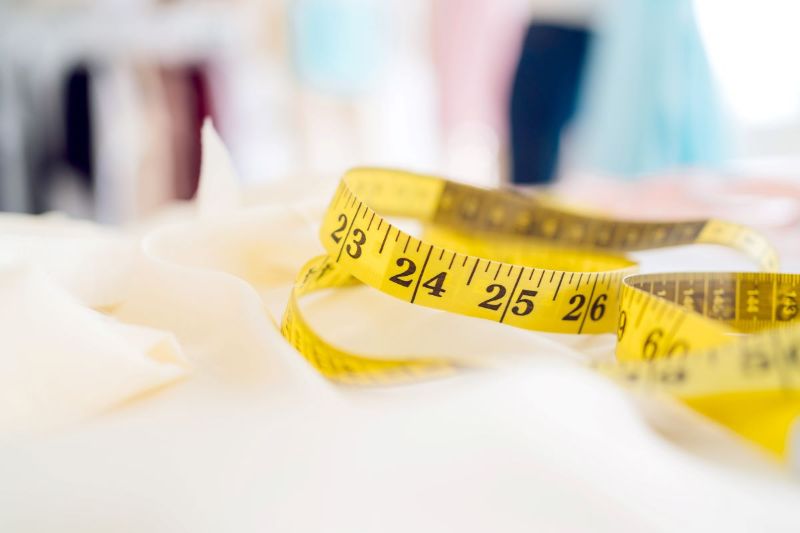Master pattern maker
"A master pattern maker has to be aware of what is going on in the textile sector. Materials are being developed fast. Interest in product development promotes cooperation with designers and pattern sewers. For drafting certified products, such as fire-proofed or cold-proofed suits, you need special expertise, which requires continuous training."

- Miia Lundell
- Master pattern maker at Image Wear Oy.
- Completed the Further Vocational Qualification for Dressmaker and the Specialist Vocational Qualification for Master Pattern Maker at the Turku Vocational Institute and a Bachelor of Culture and Arts in Clothing at the Halikko College of Crafts and Design.
- 20 years of work experience in the field.
- Briefly explain what you do for a living.
Briefly explain what you do for a living.
I work as a master pattern maker in a product development team. My job involves drafting patterns and serialising garments by modifying basic garment patterns into different sizes using a computer. I draw up measurement tables and check and fit sample garments. I am also responsible for drawing up the product structure, which involves listing the supplies used for manufacturing a garment and preparing instructions for production. I also spend time thinking how we could develop our working methods.
How have you ended up in the profession of your choice?
When I was a child, my mother did a lot of sewing, and we often wore homemade clothes. I also designed, drafted and sewed all the time, but I thought of it just as a hobby, and my dream was to study psychology.
After upper secondary school, however, I applied to Halikko to study for a Bachelor of Culture and Arts in Clothing. During the studies, I realised that I specifically wanted to draft, prepare cutting plans and consider working methods and cost-effectiveness. I was most interested in working in industry, in serial textile production.
Describe your typical working day or week.
My workdays usually start the same way. First, I will go through the ongoing work with the pattern sewing teams, and we work together to solve any challenges that have come up. I then check my email and other communication channels. I reply to messages and make sure that urgent matters are handled.
From then on, my workdays vary a lot. When I am drafting completely new products, I work closely with the designer, sales, procurement and manufacturing. Drafting is very independent work that you do on the computer. It allows me to use my creativity and make independent decisions.
I select or suggest which threads, buttons, snaps, zippers and ribbons to use in the products, and I also prepare care instructions. Then I make alignment instructions for thermo-transfer, embroidery, and other markings. In addition, I calculate how much materials and supplies are needed and go through the products with the pattern sewer. Finally, I prepare the cutting layouts and deliver them to the cutter.
Every workday also has some unexpected element. If challenges come up in production, we have to solve them as quickly as possible so that production does not stop. Sales employees might also need product information and sample copies at a tight schedule.
What kind of work environment or working hours do you have?
I mainly work at the office. I have the opportunity to work partially from home, but in practice, I always come to the office because I often want to talk about work face-to-face with other product development team members.
I have flexible working hours, and we have a working hours bank. I mainly work between 8 am and 6 pm.
What kind of competence or qualities are required in the profession?
A master pattern maker has to be aware of what is going on in the textile sector. Materials are being developed fast. Interest in product development promotes cooperation with designers and pattern sewers. For drafting certified products, such as fire-proofed or cold-proofed suits, you need special expertise, which requires continuous training.
Being good at three-dimensional thinking is useful in pattern drafting. You also have to know about body proportions. Mathematics is also a recommended skill, because a master pattern maker has to understand the economic impacts of different pattern solutions in serial production.
Although drafting patterns is independent work, you do have to get along with different kinds people, because a master pattern maker will participate in fittings, for example. You have to know English for working with foreigners. Creativity and problem-solving skills are also necessary.
What is the best thing about your profession?
The best moment is when I get a product into production, my solutions work as expected and I get positive feedback. I also like that I get to make very different kinds of products. It feels great to see the finished products in use.
What are the downsides of the profession or what seems challenging?
Downsides of the work include challenges that you cannot control, like overlapping and prolonged projects, which is why a master pattern maker has to tolerate pressure and incompleteness.
What would you tell a person considering the profession of a master pattern maker?
If you are independent and meticulous, enjoy solving problems and are interested in making clothes, the work of a master pattern maker could be suitable for you. You should be aware that a master pattern maker mainly works on a computer.
How do you see the future of your profession?
More and more attention is being paid to the responsibility and sustainability of clothing production chains and the origin of products. Product development will probably remain in Finland, but in the future, the work will be focused on preparing instructions, checking samples and defining dimensions. I believe that there will be demand for master pattern makers in the future as well.
